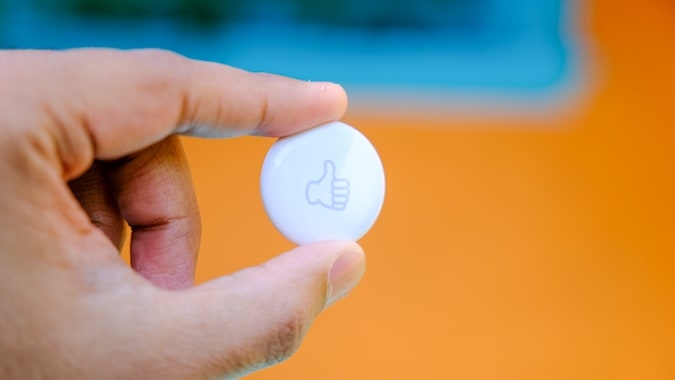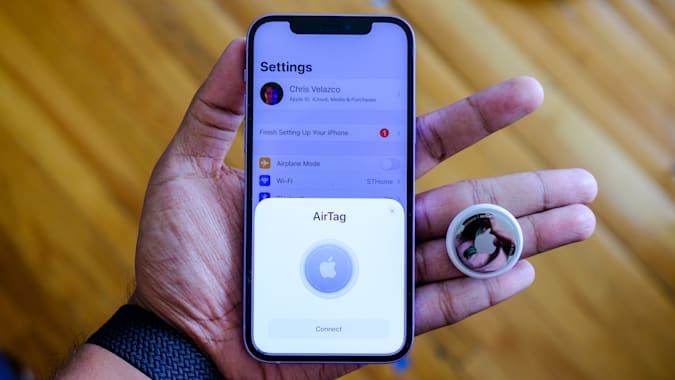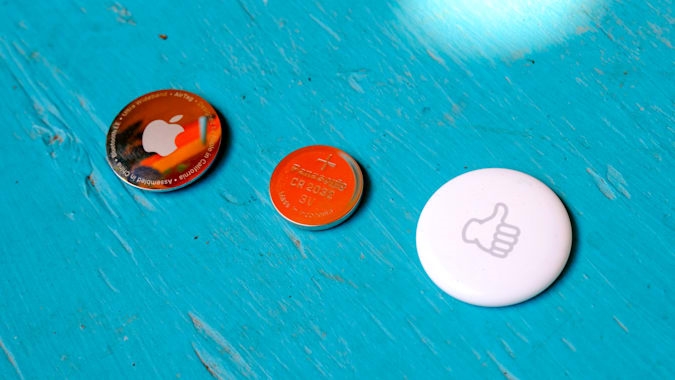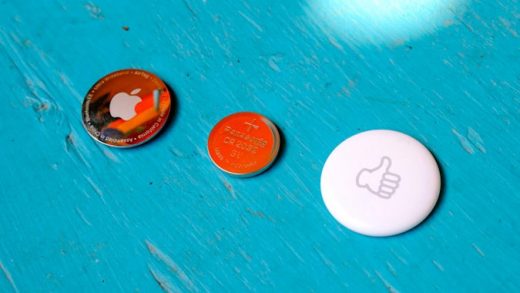Apple’s AirTag drops to $25 for Amazon Prime members at Woot
Apple’s new AirTags are as simple as they should be
Our first day with these tiny trackers was all smooth sailing.

If there’s one thing you should know about me, it’s that I. Lose. Everything. That character flaw, in tandem with a complete inability to see things smack in front of my face, sometimes means I’m perhaps the perfect person to try out Apple’s new AirTags. Good thing, then, that Apple sent along a few to test — along with a purple iPhone 12 running the new (and required) iOS 14.5 update.
Let’s just clear one thing up now, though: This is not a review! I’ve only had the AirTags for a day, which isn’t nearly enough time to properly live with these things. Still, that gave me ample opportunity to whiz through the setup process and test drive some of the AirTags’ most important features.
Before we get to that, though, we should talk about design. The AirTags themselves are a little larger than a quarter, and roughly the same size as those little buttons you’d pin to your bag or lapel. Tiny size aside, there’s a lot going on inside. Apart from the user-replaceable CR2032 battery, each AirTag packs a Bluetooth radio, NFC for pairing, and a little speaker that plays a surprisingly loud alert tone when you need it. Most importantly, AirTags contain Apple’s U1 ultra-wideband chip, a helpful sliver of silicon we’ve so far only seen in the company’s recent iPhones, the Apple Watch Series 6 and the new HomePod mini. I could go on about how the U1 actually works, but all anyone really needs to know is that it uses a high-frequency radio to act as a sort of beacon, allowing other devices with the same chip to more easily locate it.

On the whole, the design doesn’t much to be desired, though there are some things I wish Apple had thought to consider. In particular, I wish the AirTags had slightly flatter sides so I could stick one to my wallet or camera with a bit of double-sided tape. Unlike rival object trackers, such as the Tile line and Samsung’s Galaxy SmartTag, AirTags don’t have a built-in keychain ring. That means you’re forced to buy additional accessories for anything but the most basic situations, like keeping one in your backpack or purse. How very Apple.
Naturally, Apple has a slew of accessories to help you attach your AirTags to your must-have objects. I’ve mostly been using a $35 leather keyring, which isn’t nearly as compact as the Orbitkey I usually use and costs more than a single AirTag by itself. At $29 a pop, or $100 for a four-pack, AirTags are competitively priced, but expect your total outlay to swell considerably once you snap up holsters and straps to connect those trackers to your gear. (That is, unless you wait for cheapo alternatives to pop up on Amazon, which shouldn’t take more than a few days.)

Thankfully, figuring out how to attach your AirTags is the most difficult part of the process. Apple promised that setting up its object trackers will be as simple as pairing a set of AirPods, and that has indeed been my experience so far. Once you unwrap a plastic sheath and remove a tab blocking the AirTag’s battery, a nearby iOS device should detect it in seconds. From there, all you need to do is give the thing a name and thumb through a basic description of features before you’re all set.
(Pro tip: If it takes a while for your iOS device to recognize your AirTags, or if the “Find” option never appears in the Find My app, make sure location services are enabled for that app. I restored this new iPhone with a backup in which I specifically disabled location awareness for Find My, and I spent the next hour wondering what the hell was going wrong.)
So, what happens when you do lose your keys or whatever? Well, you have a few options, all of which are available in iOS’s Find My app. You could always tap a button to force the AirTag to play an alert chime, and to Apple’s credit, the speaker on these things is much louder than I expected. Our video producer hid my keys somewhere in his backyard, and I could easily hear my wayward AirTag chirping over the sound of the wind, kids playing, and what I eventually found to be two guys cutting huge slats of wood in their front yard. Unless you have your TV blaring, I don’t think you’d have too much trouble finding your missing gadget with your ears alone.
Of course, the real draw here — and what the AirTags have over, say, a Tile tracker — is the Precision Finding feature. Assuming your iPhone also has a U1 chip, you can just tap the “Find” button when viewing your AirTag in the Find My app. I’m told that if you’re within standard Bluetooth range — about 30 feet or so — a big, friendly arrow will appear on your screen to direct you to your lost item. In practice, that 30 feet estimate is just that: an estimate. If you have walls or big furniture between you and that AirTag, the Find My app will ask you to walk around a bit first before it can latch on to the U1 chip’s signal. (Now would be a great time to ping the AirTag’s speaker, just to get you into the right room.)
In short, the Precision Finding feature works beautifully, and there wasn’t anywhere my video guy could stash my keys that I couldn’t find with just a bit of legwork. It doesn’t hurt that the iPhone itself provides haptic feedback during searches; the closer you get, the more sustained the vibration. The whole thing is absolutely dead-simple, just the way it should be.
In the unfortunate case that the item an AirTag is attached to is nowhere close, the tracker is meant to relay its location back to you by way of the Find My network, a growing mesh of iOS devices and compatible third-party hardware. (For what it’s worth, Apple says the Find My network is already considerable — it’s “approaching a billion Apple devices.”) What’s more, you can enable Lost Mode on an errant AirTag, which will display a notification on your phone when its location is detected, and allows you to share your phone number and a message if anyone finds the AirTag and happens to scan it.

So far, all of the object tracking basics work beautifully here, as do hallmark features like Precision Finding. Unfortunately, my limited time with the AirTags means I haven’t been able to try a few crucial things. For one, Apple says AirTags will automatically play their alert tone if they move after having been separated from their owner for a while. It’s a clever trick and should help people find AirTags that unscrupulous actors have planted on them, but for now, I haven’t been able to figure out how long it takes before the AirTag decides it might be tracking someone it shouldn’t. And since all of the AirTags I’ve tested so far have been connected to me and my Apple account, I couldn’t see for myself what it’s like when you scan someone else’s AirTag that’s been discreetly traveling with you. (In other words, stay tuned for more.)
For now, though, Apple’s AirTags make a strong first impression. They’re cheap enough, they have user-replaceable batteries, the speaker is tremendously helpful, and Precision Finding is a breakthrough for the perpetually forgetful. I definitely still have some testing to do, but if you’ve already bought into the Apple ecosystem, AirTags are shaping up to be a no-brainer of a purchase.
(23)


